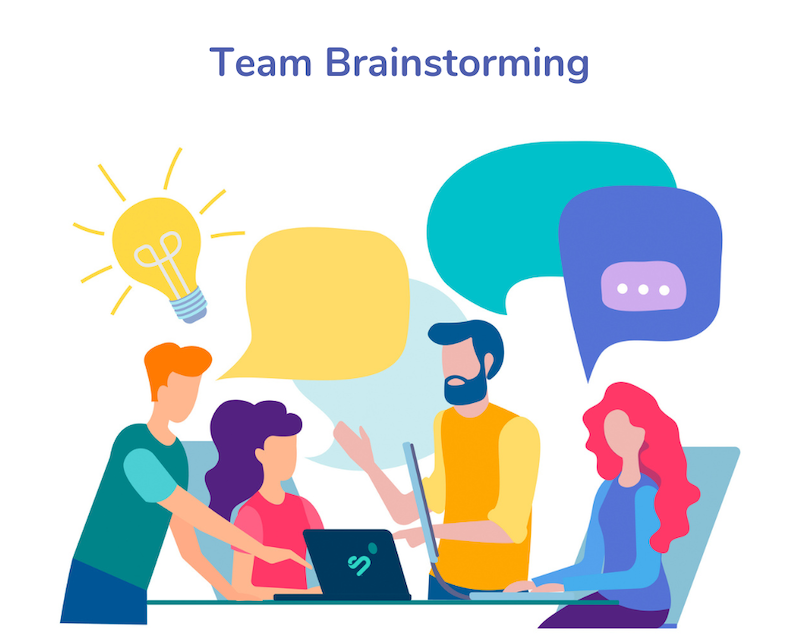Navigating team brainstorming sessions can sometimes feel like walking a tightrope.
On one side, there’s the potential for groundbreaking ideas; on the other, the risk of stifled creativity due to the fear of judgment, lack of accountability, or the overshadowing presence of dominant voices.
This precarious balance can lead to valuable insights being left unsaid, and without a mechanism to track and implement these ideas, the brilliance of collective brainstorming can fizzle out, leaving your company’s innovative edge dull in a competitive market.
However, the importance of team brainstorming cannot be overstated. It’s a powerful tool for unlocking diverse perspectives, fostering a culture of innovation, and driving your company forward.
When conducted effectively, brainstorming sessions can lead to the birth of novel solutions, enhance team cohesion, and contribute to a sense of shared purpose and direction.

We’re here to guide you through this transformative journey. In the following sections, we’ll delve into the critical benefits of team brainstorming and outline actionable steps to implement our proven best practices within your organization.
Let’s harness the collective genius of your team and pave the way for unparalleled success in the marketplace.
Page Contents (Click To Jump)
Benefits of Team Brainstorming
There are plenty of advantages to having a well-structured brainstorming process. Let’s see just how they impact team dynamics and overall company success:
✅ Keeping employees engaged
Engaging employees in the brainstorming process creates a sense of ownership and involvement in decision-making, leading to higher levels of employee satisfaction and commitment. As a result, team members will feel valued for their contributions and be eager to share their ideas more openly in the future.
✅ Helping you make better decisions
From giving you the opportunity to analyze different potential options to enabling informed decision-making based on a range of different perspectives and insights — brainstorming sessions bring together individuals with different backgrounds and expertise. This means lower risks of overlooking critical factors or making hasty judgments.
✅ Enhancing your organization’s success
More ideas simply mean more opportunities to reach your goals. After all, you’ve got your team to help you harness their collective intelligence and adapt to changing market dynamics. Moreover, effective brainstorming can promote a culture of continuous improvement and learning, positioning the company for long-term growth and sustainability.
✅ Promoting diversity and inclusion
No one wants to feel left out. Not even the shyest of employees. So a brainstorming session alone (when managed right) gives you one more chance to get everyone heard and seen.
✅ Fostering better collaboration
Let’s face it. A lot of teams struggle with collaboration. But a brainstorming session will bring everyone together, regardless of department. This cross-functional collaboration facilitates knowledge sharing, breaks down silos, and encourages teamwork across organizational boundaries. By working together on common goals and challenges, team members gain a deeper understanding of each other’s perspectives, expertise, and contributions.
Steps for Running a Successful Team Brainstorming Session
But where do you start? Here’s our recommended step-by-step process:
💡 Set better objectives
Identify what the goals and objectives of the brainstorming session are so you can provide your team with a focal point. Consider factors such as problem-solving, innovation, process improvement, or product development and how they can enhance your sessions.
💡Choose the right brainstorming technique
We’ve outlined a couple of the best ones below, but it’s important to pick the one(s) your team members are comfortable with. You should also assess the dynamics of your team, considering factors such as team size, general familiarity with brainstorming techniques, and the nature of the problem or challenge being addressed.
💡Encourage divergent creative thinking
It’s important to reassure your team that any idea, no matter how crazy or hard to put into practice, is welcomed. To do so, emphasize the value of divergent thinking by encouraging the exploration of unconventional or out-of-the-box ideas.
💡Use each idea as a reference for the next one
Encourage participants to listen actively to each other’s contributions and to leverage existing thoughts as inspiration for generating new ones. By leveraging collective insights and perspectives, the team will end up with a more thorough and clear action plan.
💡Define next steps
Develop a list of the next steps, responsibilities, and timelines for implementing the selected ideas, leaving room for reviews as well as delays and mishaps. Don’t forget to assign specific tasks to team members based on their skills and expertise, ensuring accountability and alignment with organizational goals.
Best Team Brainstorming Strategies and Techniques
On to a couple of the best tried-and-tests brainstorming methods and techniques:
1. Set Clear Objectives
By providing a clear direction and purpose, team members can align their ideas and efforts more effectively, maximizing the outcome of the brainstorming session.
Pro-tip: Use a template to define the SMART goals of the brainstorming session to foster a more systematic approach to brainstorming and enhance the quality of generated ideas.
2. Foster an Inclusive Environment
Strive for a safe and welcoming atmosphere where all team members feel valued and comfortable when contributing their ideas.
Pro-tip: Set the tone each time by starting each employee check-in with a welcoming and inclusive tone. You should also dedicate a set amount of time during check-ins to acknowledge and celebrate the diversity of your team.
3. Time Boxing
This team brainstorming strategy is effective because it creates a sense of urgency, encourages focus, prevents overthinking, and ensures that discussions remain productive.
Pro-tip: Brainstorming templates provide structured frameworks with designated time limits for each phase, facilitating focused discussions and ensuring efficient idea generation within the allotted timeframe.
4. Brainwriting
This method involves individuals writing down their ideas independently before sharing them with the group.
Pro-tip: Mind map and flowchart templates can facilitate team brainwriting by providing visual frameworks for individuals to organize and explore their innovative ideas silently before group discussion.
5. The Round Robin Technique
This brainstorming strategy implies each member sharing an idea in turn and ensures equal participation.
Pro-tip: Incorporate this technique into your daily huddles sessions to give everyone an opportunity to contribute. Plus, this helps you see if individuals are struggling with any task or have concerns regarding a strategy or direction you’re heading towards.
6. Role Storming
Role storming is a brainstorming strategy where team members adopt different personas or roles unrelated to their expertise to generate diverse ideas from varied perspectives.
Pro-tip: This brainstorming exercise could be tricky to apply with shy or new team members so begin by fostering an environment of trust and psychological safety. This will allow people to feel secure in expressing themselves without fear of criticism or judgment.
7. Use of Stimuli
The use of stimuli in team brainstorming involves introducing images, objects, or scenarios to inspire creativity and spark fresh ideas.
Pro-tip: Icebreaker templates can facilitate team brainstorming by providing structured activities to establish rapport, build trust, and create a comfortable environment.
8. Starbursting
This strategy shifts the focus from generating answers to generating questions, encouraging thorough exploration of a topic by considering various aspects.
Pro-tip: Don’t just rely on this technique alone for brainstorming ideas. Pair it with some of the others for best results and an occasional break from a monotone meeting.
9. SCAMPER Technique
This is one of the most effective group brainstorming techniques and involves applying a checklist of idea-spurring questions related to Substitute, Combine, Adapt, Modify, Put to another use, Eliminate, and Reverse.
Pro-tip: You can use your project management tool to identify elements such as components, processes, or materials that could be replaced with alternatives or modify existing project plans, schedules, or deliverables.
10. Rapid Ideation
Rapid ideation involves encouraging the quick generation of creative ideas without overthinking, leading to a free flow of creativity and exploration of out-of-the-box creative solutions.
Pro-tip: Opt for visual brainstorming methods such as whiteboards as a starting point to get to a higher number of ideas.
Challenges with Team Brainstorming
We’ve identified four core challenges that keep occurring during group brainstorming sessions and we’re sharing the best methods to overcoming them:
❗️Team members overshadowing each other
This can occur during brainstorming sessions due to various factors, including dominant personalities, hierarchical structures, or cultural norms that prioritize certain voices over others.
👉 How to overcome it: Decide on a set of rules that promote equal participation, encouraging introverts or small groups to share their ideas first, and use techniques like Round Robin sharing to give everyone a chance to contribute.
❗️Lack of diverse perspectives hindering creativity
When team members share similar backgrounds, experiences, or perspectives, you’re limited to a set range of ideas and solutions.
👉 How to overcome it: Talk to employees from distinct backgrounds, experiences, and expertise to get their feedback on how to best incorporate their perspectives and different angles in the future.
❗️A lack of focus
People can lose focus when faced with distractions or simply when they’re bored or tired.
👉 How to overcome it: Before generating ideas, set clear objectives and time limits for everyone, diversifying your meeting agenda every now and then.
❗️Fear of criticism
Being scared of voicing one’s thoughts leads to a loss of creativity and slower innovation.
👉 How to overcome it: Start by building a non-judgmental environment where everyone gets the opportunity to share their thoughts — even anonymously or in a group setting.
People Also Ask These Questions About Team Brainstorming
Q: What is the optimal group size for effective team brainstorming sessions?
- A: The optimal group size for effective team brainstorming sessions typically ranges from five to ten people. This size allows for a diverse range of perspectives and ideas without becoming too large for the facilitator to manage effectively. In smaller groups, there may be limited diversity of thought, while larger groups can lead to decreased participation and difficulty in managing the session. However, the optimal size can vary depending on factors such as the complexity of the problem being addressed and the dynamics of the team.
Q: How do you ensure that all team members actively participate in a brainstorming session?
- A: To ensure active participation from all team members, start by setting clear guidelines at the beginning of the session to encourage participation, such as no criticism of ideas, building on each other’s suggestions, and ensuring everyone gets a chance to speak. You should also consider certain structured approaches. Employ techniques like Round Robin brainstorming, where each team member takes turns offering ideas, or brainwriting, letting everyone write down ideas individually before sharing them aloud.
Q: How can remote teams conduct effective brainstorming sessions online?
- A: For remote teams to conduct online brainstorming sessions effectively, you’ll need to test out a couple of different strategies to identify what can work best for you. These include choosing the right team collaboration tools, setting clear objectives and employee KPIs, encouraging active participation, and similar.
Q: How can teams measure the effectiveness of their brainstorming sessions and the impact on project outcomes?
- A: Measuring the effectiveness of brainstorming sessions and their impact on project outcomes requires a combination of qualitative and quantitative methods to assess both the process and the results. However, you should always start by monitoring the level of participation from team members during brainstorming sessions. This will allow you to identify what current challenges your team is experiencing, asses idea quality, and identify future action steps.




















